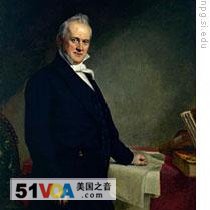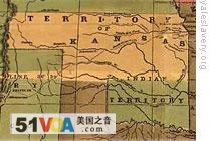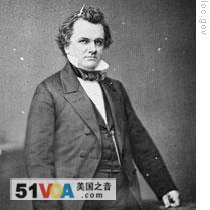2009-5-20
Welcome to THE MAKING OF A NATION – American history in VOA Special English.
Early in eighteen fifty-seven, the United States Supreme Court announced one of its most important rulings. The high court decided the case of a slave named Dred Scott.
This week in our series, Harry Monroe and Leo Scully tell us about the ruling, and the continuing national debate over slavery.
VOICE ONE:
 |
| Dred Scott |
The Supreme Court ruled that Congress did not have the power to close territories to slavery. It said the Missouri Compromise was a violation of the United States Constitution, and that Dred Scott was not a free man.
VOICE TWO:
 |
| James Buchanan |
This did not happen. The Dred Scott decision did not calm the storm that divided the nation. Instead, it increased its fury.
VOICE ONE:
New trouble threatened to break out in the territory of Kansas between pro-slavery and anti-slavery settlers. In the past few years, the two sides had argued and fought over their opinions. They even had formed two separate governments. The pro-slavery forces controlled the legal government. The anti-slavery forces controlled an opposition government which had no power.
Supporters of slavery wanted to organize a constitutional convention that could put Kansas into the Union as a slave state. The pro-slavery legislature passed a bill calling for such a convention.
The bill gave supporters of slavery every chance to control the election of delegates to the convention. And it gave the convention complete freedom to make its own rules. The bill provided no way for the people of Kansas to vote on their own constitution.
VOICE TWO:
 |
| A Civil War period photograph of John Geary |
Governor Geary had been living under extreme tension for months. He had worked hard to keep Kansas peaceful. He was angry, because he could get no help from the federal government. He sent his resignation to President Buchanan.
Then the former governor spoke publicly. He said most of the settlers in Kansas were peace-loving people. He said only a small group was responsible for the trouble there. Geary said a few powerful men hoped to make Kansas a slave state. If this failed, Geary said, they hoped their actions would produce civil war.
VOICE ONE:
President Buchanan appointed a new governor for Kansas. Buchanan told him that slavery in the territory must be decided on the votes of the people of the territory. And he said the people must be given a fair chance to approve or reject a constitution for statehood.
The new governor arrived in Kansas at the end of May, eighteen fifty-seven. He explained his policies in a speech to the people of Kansas. The new governor promised to enforce the laws of the pro-slavery legislature -- but only those laws which were constitutional. He urged everyone to vote in the coming election of delegates to the constitutional convention.
He said he was hopeful that the convention would offer its constitution to the people for their approval or rejection. He added that Congress would not accept Kansas as a slave state, or a free state, until the people had voted on the question of slavery.
VOICE TWO:
On June fifteenth, the election was held for delegates to the constitutional convention. Most anti-slavery men did not vote, because their names had been kept off the voting lists by pro-slavery officials. Others refused to vote, because they believed the election was unfair.
Sixty delegates were elected. All supported slavery. They planned to meet in the autumn to begin work on a constitution for Kansas.
Most of the delegates were wild, rough men who found it difficult to read and write. But these men were sure of one thing. They wanted Kansas to be a slave state.
VOICE ONE:
 |
| Territory of Kansas |
Then they wrote the different parts of the document. One part of the constitution severely limited the right of the legislature to free slaves. Another part barred free negroes from entering Kansas. And another prevented the constitution from being changed for seven years.
VOICE TWO:
Most of the delegates to the Kansas constitutional convention wanted to send the document directly to Congress for approval. They did not want to give the people of Kansas a chance to vote on it. They were sure that the majority of the population would reject a constitution that made slavery legal.
Some delegates, however, knew that Congress would not approve statehood for Kansas unless the people voted on the constitution. The two sides finally agreed on a compromise.
VOICE ONE:
The constitution itself would not be offered to the people. Instead, the people would vote only on the question of slavery. They could vote for the constitution with slavery or the constitution without slavery.
If the voters approved the constitution with slavery, then Kansas would be open to new slaves. If they approved the constitution without slavery, then Kansas would be closed to new slaves. Slaves already in the territory could be kept there.
This compromise brought a cry of anger from opponents of slavery in Kansas. They said the constitutional convention had only given them the right to vote for limited slavery or unlimited slavery. It had not given them the right to vote for freedom.
VOICE TWO:
President Buchanan had promised the people of Kansas that they would have a fair chance to vote on their constitution. But members of his cabinet told him to forget this promise.
They said Americans were tired of the dispute in Kansas and would accept any settlement. They told Buchanan that approval of the constitution would end the Kansas problem. It would satisfy the South, they said, and the North would soon forget about Kansas.
Under this pressure, President Buchanan made his decision. He would ask Congress to accept the pro-slavery Kansas constitution and make the territory a slave state.
VOICE ONE:
In Kansas, the vote on slavery was held. Most opponents of slavery did not vote. They were waiting until they could vote against the complete statehood constitution.
Many of the votes were illegal. Still, Kansas officials declared that slavery had been approved. They urged Congress to make Kansas a state under this condition. Shortly after, President Buchanan sent Congress a similar message.
Buchanan's chief opponent on the statehood bill was a member of his own Democratic Party, Senator Stephen Douglas of Illinois. Douglas did not oppose slavery. But he believed that the people of a territory had the right to make their own decision to accept or reject slavery.
VOICE TWO:
 |
| Stephen Douglas |
The House of Representatives, however, rejected the bill. Instead, it approved a bill to let the people of Kansas vote again on their statehood constitution. The Senate approved a compromise version of this House bill.
VOICE ONE:
So the people of Kansas got another chance to show that they did not want a pro-slavery constitution. They voted and rejected the constitution by a large majority.
The pro-slavery statehood constitution was dead. Kansas would continue as a territory for a few more years. But there would be no further attempt to make it a slave state.
(MUSIC)
ANNOUNCER:
Our program was written by Frank Beardsley. The narrators were Harry Monroe and Leo Scully. Transcripts, MP3s and podcasts of our programs can be found, along with historical images, at 51voa.com. And you can follow our series on Twitter at twitter.com/voalearnenglish, spelled as one word. Join us again next week for THE MAKING OF A NATION -- an American history series in VOA Special English.
___
This is program #85 of THE MAKING OF A NATION